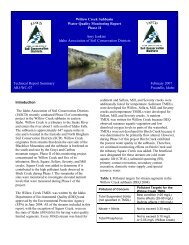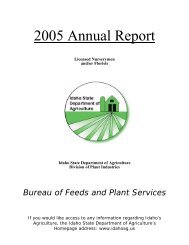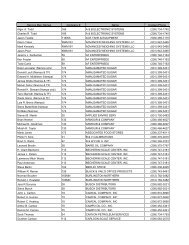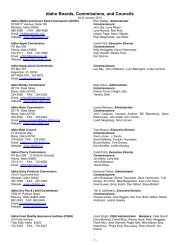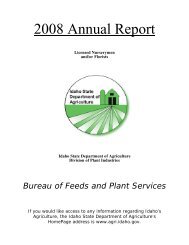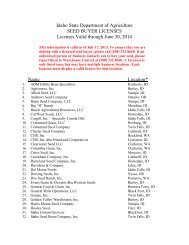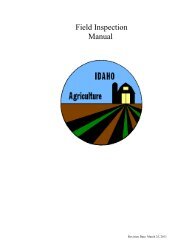2008 Statewide Strategic Plan for Eurasian Watermilfoil in Idaho
2008 Statewide Strategic Plan for Eurasian Watermilfoil in Idaho
2008 Statewide Strategic Plan for Eurasian Watermilfoil in Idaho
Create successful ePaper yourself
Turn your PDF publications into a flip-book with our unique Google optimized e-Paper software.
species or the reduction of their population density below susta<strong>in</strong>able levels” (Myers, et al 2000).<br />
Leavitt, <strong>in</strong> regards to weed eradication <strong>in</strong> Cali<strong>for</strong>nia, has given a similar def<strong>in</strong>ition and also<br />
contrasts eradication with control: “What exactly does eradication mean? It means that every plant<br />
or plant part capable of reproduction is removed from a def<strong>in</strong>ed area… whereas control means the<br />
temporary suppression of plant germ<strong>in</strong>ation, emergence, or growth sufficiently enough so that<br />
crop, <strong>for</strong>est, range production, highway safety, or other goals can be achieved <strong>for</strong> a season. Once<br />
eradication is accomplished, treatments can stop; with control, treatments must cont<strong>in</strong>ue year after<br />
year” (Leavitt 2006).<br />
Abstract def<strong>in</strong>itions do not give operational guidance as program endpo<strong>in</strong>ts are difficult, if not<br />
impossible, to def<strong>in</strong>e <strong>in</strong> practice. For this reason, the Cali<strong>for</strong>nia Department of Food and<br />
Agriculture (CDFA) adopt the follow<strong>in</strong>g operational def<strong>in</strong>ition of eradication <strong>in</strong> its Hydrilla (Hydrilla<br />
verticillata) Eradication Program: “If no hydrilla plants are detected after three years of <strong>in</strong>tensive<br />
survey, a Declaration of Eradication will be issued by the Department. However, if a plant is<br />
detected dur<strong>in</strong>g this period, treatments would be <strong>in</strong>itiated and another three consecutive years of<br />
negative survey will be required be<strong>for</strong>e a declaration can be issued” (CDFA 2005). The CDFA’s<br />
terrestrial weed eradication programs also use the negative survey <strong>for</strong> “three consecutive years”<br />
rule (Rejmanek and Pitcairn 2002). In Australia, weed control managers used a “no plants had<br />
been detected <strong>for</strong> 5 years or more” as the operational def<strong>in</strong>ition of “eradication” <strong>for</strong> a kochia<br />
(Bassia scoparia) eradication program (Dodd and Randall 2002). Five years was adopted<br />
because this was considered the upper limit <strong>for</strong> seed persistence of this species.<br />
The elim<strong>in</strong>ation of EWM from a def<strong>in</strong>ed area will require control of all EWM stems and leaves,<br />
control of the root crown and stolons, and control of new plants sprout<strong>in</strong>g from EWM fragments<br />
and seeds. There<strong>for</strong>e, the ISDA def<strong>in</strong>ition of “eradication” may be an adequate operational<br />
endpo<strong>in</strong>t <strong>for</strong> their EWM Eradication Program if adequate underwater surveys are conducted to<br />
ensure control of all plant parts, the root crown, and new sprouts from def<strong>in</strong>ed areas. However,<br />
the review panel did detect considerable confusion over the statutory def<strong>in</strong>ition from both an<br />
operational and public understand<strong>in</strong>g perspective.<br />
Panetta and Lawes have <strong>in</strong>troduced three criteria “by which progress towards the weed<br />
eradication objective may be evaluated” (Panetta and Lawes 2005). These are: delimitation,<br />
conta<strong>in</strong>ment and ext<strong>in</strong>ction. “Delimitation” refers to the ability to f<strong>in</strong>d all the plants. “Conta<strong>in</strong>ment”<br />
refers to prevent further spread and to prevent re-<strong>in</strong>festation. “Ext<strong>in</strong>ction” is their word <strong>for</strong><br />
elim<strong>in</strong>ation.<br />
Recommendation 6.1: Clarification of the program goals<br />
The ISDA EWM Eradication Program can be successful if it detects and delimits all of the EWM<br />
<strong>in</strong>festations statewide (not just <strong>in</strong> cooperat<strong>in</strong>g Weed Management Areas), if it prevents movement<br />
of EWM fragments <strong>in</strong>to new areas or prevents them from re-<strong>in</strong>fest<strong>in</strong>g old areas, and if it elim<strong>in</strong>ates<br />
all plant parts as described above. However, one concern of the EWM Program Review Panel is<br />
that prevention of re-<strong>in</strong>festation may not be an achievable goal <strong>in</strong> <strong>Idaho</strong> waterways that are<br />
contiguous with EWM <strong>in</strong>fested adjacent states. Long-term eradication may not be achievable <strong>in</strong><br />
these waterways, but eradication <strong>in</strong> the current grow<strong>in</strong>g season, as per the ISDA def<strong>in</strong>ition of<br />
eradication, may still be achievable. A more workable program goal would be to (1) aggressively<br />
reduce the presence of EWM to non-readily detectable levels <strong>in</strong> those enclosed waterbodies<br />
where deemed practically and economically feasible and (2) reduce EWM populations to levels<br />
that do not significantly <strong>in</strong>terfere with fish, wildlife or public recreation use of the water body <strong>in</strong><br />
those large open, mov<strong>in</strong>g water systems. Such a program will require the development of site<br />
specific management objectives <strong>in</strong> cooperation with concerned entities.<br />
ISDA Response: ISDA will consider the proposed def<strong>in</strong>itions.<br />
66



